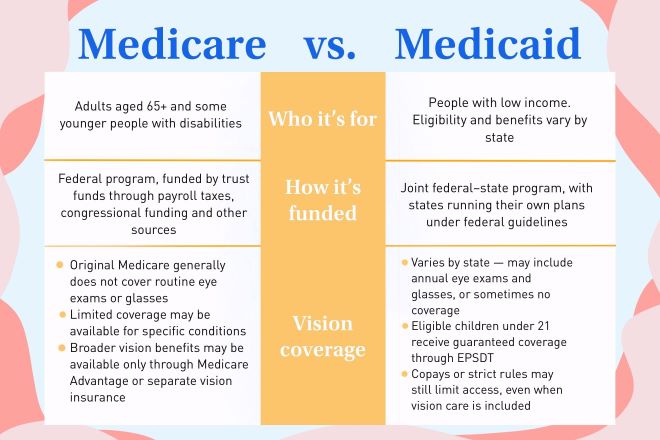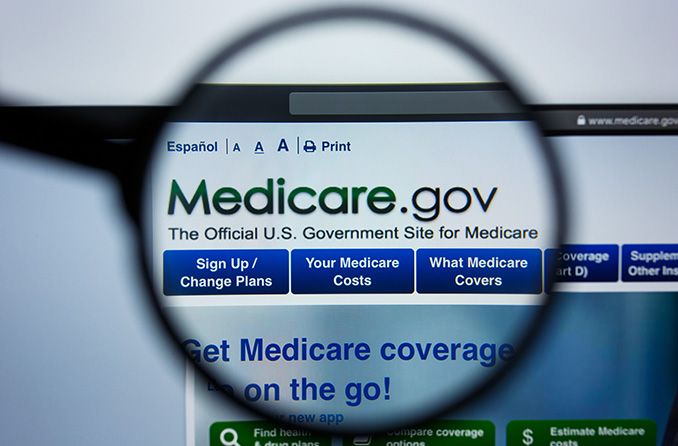Introduction to vision benefits
Vision care is important for overall health, but coverage works very differently under Medicare and Medicaid. Original Medicare plans generally do not cover routine eye exams or glasses. However, Medicaid vision coverage may be available for both eye exams and glasses, depending on where you live.
Understanding these differences can help you make the most of your benefits. Plan options can vary, so it is important to review your specific plan to know what is included.
Understanding Medicare vision benefits
Learning how Medicare works is the first step in knowing what vision benefits may be available to you. By discovering the basics of the program, you can better navigate your options for eye care coverage.
What is Medicare?
Medicare is a health insurance program run by the federal government that is designed for adults aged 65 and older, along with some younger people who qualify due to certain disabilities. It helps pay for a range of healthcare services, but it does not pay for every expense or provide most extended care services. Participants can choose to receive their coverage through Original Medicare or a Medicare Advantage plan.
Original Medicare
Original Medicare includes Part A (hospital insurance) and Part B (medical insurance). You can also purchase a Medicare Supplement Insurance (Medigap) policy from a private company to help cover additional costs.
Medicare Advantage
Medicare Advantage plans are offered by Medicare-approved private companies. These plans combine Part A and Part B, and most also include Part D (prescription drug coverage) in one plan.
Vision coverage under Medicare
Original Medicare typically does not pay for routine vision care, such as standard eye exams or glasses. People who want vision benefits may be able to get them through separate vision insurance or by selecting a Medicare Advantage plan that includes vision services.
In some special circumstances, Medicare Part B may help cover certain vision-related costs, including for conditions such as:
- Diabetes or diabetic retinopathy – Includes one yearly eye exam for diabetic retinopathy when performed by a qualified eye doctor
- Age-related macular degeneration – Involves testing and certain treatments to help manage the condition and protect vision
- Glaucoma – Provides one screening every year for individuals at high risk
- Cataracts – May cover surgery with intraocular lenses (varies based on your location), plus one pair of glasses or contact lenses afterward
Exploring Medicaid vision benefits
Vision benefits through Medicaid can look very different, depending on where you live. Knowing how your state’s program works can help you understand what care might be available.
What is Medicaid?
Medicaid is a public health insurance program run by the federal government and individual states. It helps people with low incomes receive medical care. Each state runs its own plan while following the basic guidelines set by the federal government. The services offered and the rules for who qualifies are dependent on the state.
Vision coverage under Medicaid
Vision coverage with Medicaid varies from state to state. Some states may offer Medicaid coverage for annual eye exams and glasses, while others may offer no coverage at all. However, copays and strict policy rules can still prevent people from getting exams or glasses, even when their state includes vision care in its coverage.
Children under the age of 21 who are eligible for Medicaid may have access to vision coverage through the Early and Periodic Screening, Diagnostic and Treatment (EPSDT) benefit. This ensures proper preventive care that includes vision screenings at each well-child visit.
Comparing Medicare and Medicaid vision benefits
Looking at both Medicare and Medicaid programs side by side can make it easier to see how they differ and which you may be eligible for. This comparison can guide you in finding the coverage that best supports your eye health needs.

Key differences in coverage
The U.S. Treasury pays for Medicare using two trust funds. These funds rely on payroll taxes, congressional funding and other revenue sources. People with Medicare share some costs. This includes monthly premiums, deductibles and part of the bills for medical care and prescriptions.
Medicaid is a program for those with low income and can include services that Medicare usually does not include, like long-term nursing care. The Affordable Care Act, passed in 2010, gave states the option to expand Medicaid so it could include almost all Americans under 65 with low incomes.
Choosing the right plan for you
The best vision coverage depends on your unique situation. Compare what each program offers and consider how they match your needs.
If you only have Original Medicare, you might need a separate plan for vision coverage. If you have Medicaid, check your state’s benefits to see if vision care is included.
If you qualify for both Medicare and Medicaid, known as dual eligibility, you may be able to get a plan designed to coordinate both programs, which can help you receive more benefits.
Additional resources and support
Many resources are available to help you learn more about your coverage options, as well as how to apply for benefits.
How to apply for Medicare and Medicaid
Before you can receive benefits, you’ll need to apply for Medicare or Medicaid. The application steps will vary, depending on which program you are applying for.
Applying for Medicare
You can apply for Medicare by:
- Calling a Social Security representative.
- Visiting the Social Security website.
- Going in person to your local Social Security location.
For your application, you will need to provide:
- Your full name and other basic personal details.
- Your Social Security number.
- The city, state and country where you were born.
- Details about your health insurance coverage.
- Dates when any current group health plan began and ended.
- Dates when any group health plan began and ended after age 65.
- An active email address (for Part B only).
- Your current Medicare identification number (for Part B only).
Applying for Medicaid
You can sign up for Medicaid at any time by:
- Contacting your state’s Medicaid office to start your application. You must apply in the state where you currently reside.
- Applying through the Health Insurance Marketplace. If you or someone in your household appears to qualify, your state’s Medicaid office will receive your information and follow up with you.
When you apply, you may need to give:
- Your full name.
- Your date of birth.
- Your Social Security number.
- The amount you pay each month for housing and utilities.
- Your U.S. citizenship or legal immigration status.
- Recent pay stubs or a W-2 form for proof of income.
- A list of other government benefits you get.
- Details about any health insurance you have now.
- Specifics regarding health insurance that has been made available by an employer.
Where to find more information
More information can be found about Medicare and Medicaid vision benefits at their respective websites. There, you can also find information about other benefits, applications and more. Other resources include:
- The Social Security Administration
- The National Council on Aging
- The U.S. General Services Administration
Medicare vs. Medicaid vision benefits
Comprehensive eye exams and other routine eye care are important parts of protecting your vision and overall health. By learning how Medicare and Medicaid handle vision coverage, you can choose the plan that best fits your needs. Taking the time to review your benefits ensures you can get the care and services that support your eye health.







